Content [show]
Houseplants are of great importance in human life; they decorate our life, everyone loves them and grows them everywhere.
Many would like to be engaged not only in indoor floriculture, but also in fruit growing, to get their own lemons or, for example, to grow grapes from seeds at home.
Practice shows that it is possible to grow grapes in an apartment, using the so-called tub (pot) method.
Practice shows that it is possible to grow grapes in an apartment or on a balcony, using the so-called tub (pot) method.
Living on the 5-7th floor of a stone house and having a small balcony with an area of only 1-2 square meters, you can grow up to 3 vines.
Having a desire to grow indoor grapes and harvest without spending more time than taking care of ficuses, palms, geraniums, you can be in Kharkov, Kiev or living on the 15th floor of a high-rise building in any other city.
Indoor grape varieties
In a closed room, it is better to grow self-pollinating varieties.
These include: large raisins Neptun, early Victoria grapes, Victoria wine variety, seedless Rylines pink sidlis, pink grapes Oleg (Diamant), very early Aksinya (up to 100 days), the traditional Georgian wine variety Saperavi northern and of course resistant to diseases Moldavian cardinal (1-5-58).
For the growth of vines, a light frame or wire supports are arranged.
Growing grapes at home by grafting, cuttings or seeds
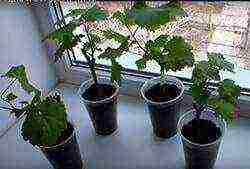 Grapes are propagated by seeds, cuttings, layering and grafting.
Grapes are propagated by seeds, cuttings, layering and grafting.
When grapes are propagated by seeds, it bears fruit only for 5-7 years, while, from seeds, due to cross-pollination, not always the desired variety grows.
The upbringing of seedlings requires care with high agricultural technology, which is not always possible due to the conditions of vat keeping.
By grafting, grapes propagate only when it is necessary to have a root system of the bush that is more frost-resistant than the crown, which is unnecessary for tub breeding. The grafting technique is complex and requires a lot of experience from the grower.
It is easy to grow grapes by cuttings, and both woody (last year's) cuttings and summer green cuttings are easily rooted (see How to root grapes).
Landing
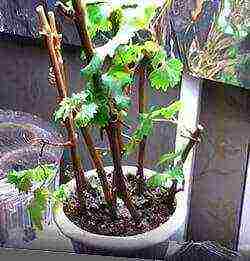 For growing grapes in a room, a soil substrate is prepared as follows: take a third of humus, a third of sod land and the same amount of river sand. It is advisable to add 1 glass of wood ash (ash) or half a glass of complex mineral fertilizer to the prepared mixture. You can buy ready-made universal soil for planting a seedling, but you need to choose with a neutral pH reaction.
For growing grapes in a room, a soil substrate is prepared as follows: take a third of humus, a third of sod land and the same amount of river sand. It is advisable to add 1 glass of wood ash (ash) or half a glass of complex mineral fertilizer to the prepared mixture. You can buy ready-made universal soil for planting a seedling, but you need to choose with a neutral pH reaction.
Cuttings are planted in small greenhouses or pots. The air temperature in the room should be within + 21 + 25. When the upper bud germinates and a sprout appears, the glass (film) from the greenhouse or glass (if it is a flower pot) is temporarily removed, thus adapting the bush to the environment ...
After the sprout reaches a height of 16–20 cm, the grapes are "loaded" into a bowl with an upper diameter of 16–18 cm. It should be noted that the roots of young grapes do not tolerate exposure very well, therefore, the integrity of the earthen coma at the roots should not be disturbed. In July, the "reloading" of the plant is repeated, but already in pots 25-35 cm in diameter. air does not fall below 2-3C heat.
In the fall, after dropping the leaves and cessation of growth, tubs with bushes are removed for the winter in dry, cool rooms, where a temperature of 2-5 degrees Celsius is provided. The vine should be rolled up in a spiral and tied to pegs.
The soil is rarely watered, just kept moist.
After dropping the leaves, pruning is done taking into account the age of the plant (grapes are formed). On an annual - leave 2-3 buds, on a 3-4 year old bush, shorten the vine to 5-10 eyes. The fruiting vine is shortened to 5-8 eyes.
In March next year, the bushes are brought into the rooms, generously watered and fertilized.
After the formation of flowers on the shoots, they are pinched over the fifth leaf behind the flower brush. Of the non-fertile, two or three, located closer to the root, are not pinched to form fruit shoots of the next year. Such shoots are pinched at a length of 1-1.5 m. Therefore, you should always have 1-2 fruit arrows on the bush (fruiting vine) and one or two growing ones for fruiting in the next year (replacement).
Grapes on the windowsill - two harvests
When growing grapes at home, you can achieve two harvests annually. This is done in the following way. The bush removed for winter storage is brought into a warm room on the 15th of February and watered well.After 13-15 days, the buds will begin to bloom, and after 25-30 days flowering will come. By May-June (depending on the early maturity of the variety), the berries are already ripening.
3 weeks after harvesting, the bush is taken to the glacier (in a cool place), where the temperature is not higher than +4 and stay there for up to 50 days (one and a half months). After that, the bush is brought into the room and at the end of October, at the beginning of November, juicy grapes will ripen in the apartment again.
After fruiting, the grapes must be transplanted, removing up to 13 roots and replacing the ground with 13. With a double harvest, it is required to give more fertilizers - usually 100 cm3 of 10% slurry solution per liter of earthen clod volume, once a week, in addition, 2 g of superphosphate is necessarily added for each liter of slurry.
Watering indoor grapes
Water plays one of the main roles in plant life: it is consumed directly by plants and is a solvent for nutrients. Bushes need a lot of water during the period of growth and fruiting, some of it remains inside the plant as an integral part of tissues and fillers, while some of it evaporates from the leaves.
With tub maintenance, a significant part of the water evaporates from the soil, the other part is consumed by the plant. Therefore, without a normal flow of water, the bushes wither, stop growing, and in some cases even die. It is necessary to give the right amount of good-quality water in a timely manner.
The temperature of the irrigation water should be at room temperature, watering should be done regularly, at very specific times, as needed, and not as soon as possible.
It is better to water the plants from watering cans, with such watering the earthy clod does not collapse and the earth is not washed out of the pot. Separate streams of water better loosen the earthen lump in the tub, in addition, such water supplies the ground and air. It is better to water the bushes in the evening, at sunset or early in the morning.
To keep the foliage clean, to wash away the dirt and dust accumulated on it, the plants are regularly washed with warm water using a soft brush or cotton swab. These washings are done two to three times during the summer. The rest of the time, "sprinkle the grapes with warm water.
When keeping grapes on the balcony during periods of rainfall, no watering or spraying is performed, since the rains sufficiently water the soil and wash the foliage.
Fertilizers
The volume of soil in a pot is ten times less than the volume occupied by roots in soil culture. Home-grown grapes receive nutrition several times less than the same bush contained in the soil. However, for the normal development of all parts of the plant, for the formation of fruits, it must receive nutrients in the required amount. A small earthen lump does not contain the necessary supply of nutrients, and those nutrients that are available are quickly absorbed, the earth is depleted and is no longer a full-fledged supplier of nutrients. And if you do not feed the bush with fertilizers, then its growth decreases, fruiting stops, and it may die.
To grow grapes in an apartment, and even more so to increase fruiting, he needs to be given artificial feeding - to apply fertilizers to the soil.
The most versatile liquid fertilizer is slurry. The slurry contains almost all the compounds from the chemicals needed by plants. And since slurry is a product of the natural decomposition of organic substances, all substances contained in it are easily absorbed by plants. The preparation of the slurry is very simple, and the results of its application give a good effect.
Preparation: we fill the container (bucket, barrel, can) by two-thirds of the volume with mullein or horse manure. Fill the free space with water and put it in a warm place for fermentation.After 14-15 days, when the fermentation process stops, we filter. We add the remains. And put the filtered liquid in a cool, dark place. We use it as needed.
For watering the plants, the resulting solution is diluted with 9 parts of water, that is, a ten percent solution of it is prepared. Before the subcortex, the soil is first watered with clean water and then carried out by watering with a slurry solution. When watering, make sure that the stems and leaves of plants are not doused with the solution. If this happens, then they should be washed with clean water.
Watering begins in early spring, is carried out weekly, and ends in August-September. On average, plants need to be watered once a week, adding a glass of solution to the soil for each kilogram.
In the second or third year of the life of the grapes, that is, when it enters the fruiting period, 2 grams of superphosphate per liter of solution are added to a 10% slurry solution.
Slurry can also be prepared from chicken droppings, in a similar way, only for watering they take not ten, but a five percent solution (one glass is diluted with twenty glasses of water).
Mineral fertilizers are used at different periods of growth, in various mixtures. The composition of the mixture depends on the need for plants in certain periods of growth in certain substances, on the degree of depletion of the soil and its composition.
For normal life, the bushes must extract a sufficient amount of potassium, nitrogen, calcium, iron, phosphorus, etc. With a shortage of nitrogen in the ground, growth is delayed, the leaves grow small, sometimes turn yellow and fall off, the flowers also become smaller and sometimes fall off before flowering. With an excess of nitrogen in the soil, on the contrary, the bushes grow too much, form many leaves, but bloom poorly.
With a lack of phosphorus, the edges of the leaves turn yellow, fungal diseases develop more easily, fruit (flower) buds are poorly formed. Some flowers may be shed before flowering, or a large number of ovaries (fertilized flowers) may be shed until the fruit is fully ripe.
Lack of potassium and calcium is characterized by weak growth (especially shoots - they grow thin), yellowing of the leaves. The lack of iron and copper salts in the soil causes the leaves to lighten and provokes the disease chlorosis - the absence (lack) of chlorophyll in the leaves.
GE Kiselev ("Indoor Floriculture", 1948) recommends the following compositions of mineral fertilizers for certain periods of growth and life of the bushes.
These mixtures are used in solutions of 1 g of the mixture per liter of water when dosing up to 200 g of solution per 1 kg of soil.
Watering with mixtures is carried out 1-2 times in 10-20 days, from April to August. The amount of watering depends on the vital activity of the plants - the more vital (rapidly growing) are watered more often, slowly - less often.
It must be remembered that a lack of nutrition, as well as an overabundance, leads to inhibition of growth, and possibly death, therefore, mineral fertilizers should be used carefully and only in cases where plants really need them.
Transfer and transfer
For the development of an active root system in the tub for the first 2-3 years of growth, the pots (tubs) are repeatedly replaced, gradually increasing their volume, transferring the bushes from a smaller dish to a larger one. When it enters the fruiting period, transshipments stop, and transplants are made every 2-3 years.
When transshipping, the bush is removed from the pot without disturbing the earthen coma and rolled into a larger pot with the addition of earth. At the same time, the drainage and upper soil layers 2-3 cm thick are necessarily replaced, the rest of the coma is not disturbed. Transshipments are made after the end of the next growth period in grapes, that is, when young shoots and leaves are ripe. During the summer period, no more than two transshipments are made.
The transshipment is carried out as follows: when growth has stopped, the bush is watered (but not abundantly) with water, the pot is tapped from all sides and, covering the top with a hand, turn it over; if the earthen lump does not separate, take a stick and, pressing it through the drainage hole, push it out of the pot.
With a blunt object, clean off 2-3 cm of the top layer of the earth and the drainage layer. Examine the root system and remove all rotten and dead roots; they differ from living ones in a darker color or even a dark brown color.
Drainage is arranged in a new dish, then 1-2 cm of sand is poured. The nutritious earth is poured in such a layer that the lump of the overflowing bush placed in the pot is 4-6 cm below the top of the pot with its upper edge. After that, the earth is poured and compacted between the walls of the pot and on top by 2-3 cm. Compaction of the earth, in order to avoid damage to the roots, is done with fingers or a blunt object. After transshipment, abundant watering and spraying of the bush with warm water are carried out.
For the first 7-10 days after transshipment, the bush is removed to a shaded place.
The transplanting technique is the same as for transshipment, only when transplanting, up to 13 soil is removed from the earthen coma, up to one third of the roots and up to one third of the crown are cut out.
The transplant is carried out in early spring or autumn, while in the first year the plant is given rest, destroying most of the fruits in their embryonic state or even removing them altogether.
Dishes (tubs, pots) are disinfected during transplantation.
It is not at all difficult to grow grapes from cuttings or seeds, the main thing is patience and attentiveness. The reward will be sweet and tasty berries.
References:
I.V. Ovsyannikov "Kadochnoe amateurish fruit growing", 1951
EAT. Makarova, V.N. Nerytov "Murom grapes", 1983
Growing grapes in an apartment - indoor grapes
Houseplants are of great importance in human life; they decorate our life, everyone loves them and grows them everywhere.
Many would like to be engaged not only in indoor floriculture, but also in fruit growing, to get their own lemons or, for example, to grow grapes from seeds at home.
Practice shows that it is possible to grow grapes in an apartment, using the so-called tub (pot) method.
Practice shows that it is possible to grow grapes in an apartment or on a balcony, using the so-called tub (pot) method.
Living on the 5-7th floor of a stone house and having a small balcony with an area of only 1-2 square meters, you can grow up to 3 vines.
Having a desire to grow indoor grapes and harvest without spending more time than taking care of ficuses, palms, geraniums, you can in Kharkov, Kiev or living on the 15th floor of a high-rise building in any other city.
Indoor grape varieties
In a closed room, it is better to grow self-pollinating varieties.
These include: large raisins Neptun, early Victoria grapes, Victoria wine variety, seedless Rylines pink sidlis, pink grapes Oleg (Diamant), very early Aksinya (up to 100 days), the traditional Georgian wine variety Saperavi northern and of course resistant to diseases Moldavian cardinal (1-5-58).
For the growth of vines, a light frame or wire supports are arranged.
Growing grapes at home by grafting, cuttings or from seeds
Grapes are propagated by seeds, cuttings, layering and grafting.
When grapes are propagated by seeds, it bears fruit only for 5-7 years, while, from seeds, due to cross-pollination, not always the desired variety grows.
The upbringing of seedlings requires care with high agricultural technology, which is not always possible due to the conditions of vat keeping.
By grafting, grapes propagate only when it is necessary to have a root system of the bush that is more frost-resistant than the crown, which is unnecessary for tub breeding.The grafting technique is complex and requires a lot of experience from the grower.
It is easy to grow grapes by cuttings, and both woody (last year's) cuttings and summer green cuttings are easily rooted (see How to root grapes).
Landing
For growing grapes in a room, a soil substrate is prepared as follows: take a third of humus, a third of sod land and the same amount of river sand.
It is advisable to add 1 glass of wood ash (ash) or half a glass of complex mineral fertilizer to the prepared mixture.
You can buy ready-made universal soil for planting a seedling, but you need to choose with a neutral pH reaction.
Cuttings are planted in small greenhouses or pots. The air temperature in the room should be within + 21 + 25.
When the upper bud sprouts and a sprout appears, the glass (film) from the greenhouse or glass (if it is a flower pot) begins to be removed for a while, thus making the bush adapt to the environment.
After the sprout reaches a height of 16–20 cm, the grapes are "loaded" into a bowl with an upper diameter of 16–18 cm. It should be noted that the roots of young grapes do not tolerate exposure very well, therefore, the integrity of the earthen coma at the roots should not be disturbed.
In July, the "reloading" of the plant is repeated, but already in pots with a diameter of 25-35 cm. Grapes are taken out into the open air no earlier than the second half of April or better - early May, depending on local weather conditions, ie.
at a time when the temperature of the air does not fall below 2-3C heat.
In the fall, after dropping the leaves and cessation of growth, tubs with bushes are removed for the winter in dry, cool rooms, where a temperature of 2-5 degrees Celsius is provided. The vine should be rolled up in a spiral and tied to pegs.
The soil is rarely watered, just kept moist.
After dropping the leaves, pruning is done taking into account the age of the plant (grapes are formed). On an annual - leave 2-3 buds, on a 3-4 year old bush, shorten the vine to 5-10 eyes. The fruiting vine is shortened to 5-8 eyes.
In March next year, the bushes are brought into the rooms, generously watered and fertilized.
After the formation of flowers on the shoots, they are pinched over the fifth leaf behind the flower brush.
Of the non-fertile, two or three, located closer to the root, are not pinched to form fruit shoots of the next year. Such shoots are pinched at a length of 1-1.5 m.
Therefore, you should always have 1-2 fruit arrows on the bush (fruiting vine) and one or two growing ones for fruiting in the next year (replacement).
Grapes on the windowsill - two harvests
When growing grapes at home, you can achieve two harvests annually. This is done in the following way.
The bush removed for winter storage is brought into a warm room on the 15th of February and watered well. After 13-15 days, the buds will begin to bloom, and after 25-30 days flowering will come.
By May-June (depending on the early maturity of the variety), the berries are already ripening.
3 weeks after harvesting, the bush is taken to the glacier (in a cool place), where the temperature is not higher than +4 and stay there for up to 50 days (one and a half months). After that, the bush is brought into the room and at the end of October, at the beginning of November, juicy grapes will ripen in the apartment again.
After fruiting, the grapes must be transplanted, removing up to 13 roots and replacing the ground with 13.
With a double harvest, it is required to give more fertilizers - usually 100 cm3 of 10% slurry solution per liter of earthen clod volume, once a week, in addition, 2 g of superphosphate is necessarily added for each liter of slurry.
Watering indoor grapes
Water plays one of the main roles in plant life: it is consumed directly by plants and is a solvent for nutrients.
Bushes need a lot of water during the period of growth and fruiting, some of it remains inside the plant as an integral part of tissues and fillers, while some of it evaporates from the leaves.
With tub maintenance, a significant part of the water evaporates from the soil, the other part is consumed by the plant. Therefore, without a normal flow of water, the bushes wither, stop growing, and in some cases even die. It is necessary to give the right amount of good-quality water in a timely manner.
The temperature of the irrigation water should be at room temperature, watering should be done regularly, at very specific times, as needed, and not as soon as possible.
It is better to water plants from watering cans; with such watering, the earthy clod does not collapse and the earth is not washed out of the pot.
Separate streams of water better loosen the earthen lump in the tub, in addition, such water supplies the ground and air.
It is better to water the bushes in the evening, at sunset or early in the morning.
To keep the foliage clean, to wash away the dirt and dust accumulated on it, the plants are regularly washed with warm water using a soft brush or cotton swab. These washings are done two to three times during the summer. The rest of the time, "sprinkle the grapes with warm water.
When keeping grapes on the balcony during periods of rainfall, no watering or spraying is performed, since the rains sufficiently water the soil and wash the foliage.
Fertilizers
The volume of soil in a pot is ten times less than the volume occupied by roots in soil culture. Home-grown grapes receive nutrition several times less than the same bush contained in the soil.
However, for the normal development of all parts of the plant, for the formation of fruits, it must receive nutrients in the required amount.
A small earthen lump does not contain the necessary supply of nutrients, and those nutrients that are available are quickly absorbed, the earth is depleted and is no longer a full-fledged supplier of nutrients.
And if you do not feed the bush with fertilizers, then its growth decreases, fruiting stops, and it may die.
To grow grapes in an apartment, and even more so to increase fruiting, he needs to be given artificial feeding - to apply fertilizers to the soil.
The most versatile liquid fertilizer is slurry. The slurry contains almost all the compounds from the chemicals needed by plants.
And since slurry is a product of the natural decomposition of organic substances, then all the substances contained in it are easily absorbed by plants.
The preparation of the slurry is very simple, and the results of its application give a good effect.
Preparation: we fill the container (bucket, barrel, can) by two-thirds of the volume with mullein or horse manure. Fill the free space with water and put it in a warm place for fermentation.
After 14-15 days, when the fermentation process stops, we filter. We add the remains. And put the filtered liquid in a cool, dark place. We use it as needed.
For watering the plants, the resulting solution is diluted with 9 parts of water, that is, a ten percent solution of it is prepared.
Before the subcortex, the soil is first watered with clean water and then carried out by watering with a slurry solution.
When watering, make sure that the stems and leaves of plants are not doused with the solution. If this happens, they should be washed with clean water.
Watering begins in early spring, is carried out weekly, and ends in August-September. On average, plants need to be watered once a week, adding a glass of solution to the soil for each kilogram.
In the second or third year of the life of the grapes, that is, when it enters the fruiting period, 2 grams of superphosphate per liter of solution are added to a 10% slurry solution.
Slurry can also be prepared from chicken droppings, in a similar way, only for watering they take not ten, but a five percent solution (one glass is diluted with twenty glasses of water).
Mineral fertilizers are used in different periods of growth, in different mixtures. The composition of the mixture depends on the need for plants in certain periods of growth in certain substances, on the degree of depletion of the soil and its composition.
For normal life, the bushes must extract a sufficient amount of potassium, nitrogen, calcium, iron, phosphorus, etc.
With a shortage of nitrogen in the ground, growth is delayed, the leaves grow small, at times turn yellow and fall off, the flowers also become smaller and sometimes fall off before flowering.
With an excess of nitrogen in the soil, on the contrary, the bushes grow too much, form many leaves, but bloom poorly.
With a lack of phosphorus, the edges of the leaves turn yellow, fungal diseases develop more easily, fruit (flower) buds are poorly formed. Some flowers may be shed before flowering, or a large number of ovaries (fertilized flowers) may be shed until the fruit is fully ripe.
Lack of potassium and calcium is characterized by weak growth (especially shoots - they grow thin), yellowing of the leaves. The lack of iron and copper salts in the soil causes the leaves to lighten and provokes the disease chlorosis - the absence (lack) of chlorophyll in the leaves.
G. Ye. Kiselev ("Indoor Floriculture", 1948) recommends the following compositions of mineral fertilizers for certain periods of growth and life of bushes.
These mixtures are used in solutions of 1 g of the mixture per liter of water when dosing up to 200 g of solution per 1 kg of soil.
Watering with mixtures is carried out 1-2 times in 10-20 days, from April to August. The amount of watering depends on the vital activity of the plants - the more vital (rapidly growing) are watered more often, slowly - less often.
It must be remembered that a lack of nutrition, as well as an overabundance, leads to inhibition of growth, and possibly death, therefore, mineral fertilizers should be used carefully and only in cases where plants really need them.
Transfer and transfer
For the development of an active root system in the tub for the first 2-3 years of growth, the pots (tubs) are repeatedly replaced, gradually increasing their volume, transferring the bushes from a smaller dish to a larger one. When it enters the fruiting period, transshipments stop, and transplants are made every 2-3 years.
When transshipping, the bush is removed from the pot without disturbing the earthen coma and rolled into a larger pot with the addition of earth.
At the same time, the drainage and upper soil layers 2-3 cm thick are necessarily replaced, the rest of the coma is not disturbed. Transshipments are made after the end of the next growth period for grapes, i.e.
when young shoots and leaves are ripe. During the summer period, no more than two transshipments are made.
The transshipment is carried out as follows: when growth has stopped, the bush is watered (but not abundantly) with water, the pot is tapped from all sides and, covering the top with a hand, turn it over; if the earthen lump does not separate, take a stick and, pressing it through the drainage hole, push it out of the pot.
With a blunt object, clean off 2-3 cm of the top layer of the earth and the drainage layer. Examine the root system and remove all rotten and dead roots; they differ from living ones in a darker color or even a dark brown color.
Drainage is arranged in a new dish, then 1-2 cm of sand is poured. The nutritious earth is poured in such a layer that the lump of the overflowing bush placed in the pot is 4-6 cm below the top of the pot with its upper edge.
After that, the earth is poured and compacted between the walls of the pot and on top by 2-3 cm. Compaction of the earth, in order to avoid damage to the roots, is done with fingers or a blunt object.
After transshipment, abundant watering and spraying of the bush with warm water are carried out.
For the first 7-10 days after transshipment, the bush is removed to a shaded place.
The transplanting technique is the same as for transshipment, only when transplanting, up to 13 soil is removed from the earthen coma, up to one third of the roots and up to one third of the crown are cut out.
The transplant is carried out in early spring or autumn, while in the first year the plant is given rest, destroying most of the fruits in their embryonic state or even removing them altogether.
Dishes (tubs, pots) are disinfected during transplantation.
It is not at all difficult to grow grapes from cuttings or seeds, the main thing is patience and attentiveness. The reward will be sweet and tasty berries.
References:
I.V. Ovsyannikov "Kadochnoe amateurish fruit growing", 1951
EAT. Makarova, V.N. Nerytov "Murom grapes", 1983
Cissus is an indoor grape. Home care and cultivation. Planting and breeding -
Cissus is an unpretentious ampelous plant from the Grape family. Many flower growers love him. People call it indoor grape or birch.
The Cissus genus has about 300 plant species. They are common in the tropics and subtropics. Typically, cissus are vines that cling to supports with their antennae.
The leaves of these plants are whole and dissected.
Indoor grapes cannot boast of lush flowering. It blooms quite rarely. Nondescript, pale cissus flowers are collected in false umbellate inflorescences. Cissus is prized for its beautiful ornamental leaves. It is grown in hanging pots.
Caring for him is simple, the plant is great for novice growers. He will be able to plant greenery in an apartment, an office, and the hall of a larger building. Indoor conditions are most often grown cissus rhomboid, antarctic and multicolored.
Cissus: care and cultivation at home
Temperature
Indoor grapes are thermophilic plants. In the spring and summer, he prefers a temperature of 18-25 degrees. In addition, it can be taken outside in the summer.
In the autumn-winter period, he will be comfortable at a temperature of 18 degrees. It can withstand temperatures as low as 10 ° C, but in such conditions it is better not to contain it.
Antarctic cissus can grow at a temperature of 5 ° C, but the capricious multi-colored cissus needs a constant room temperature throughout the year. It must not fall below 16 ° C.
It should be borne in mind that cissus does not tolerate drafts. Due to the sudden changes in temperature, indoor grapes can shed their leaves.
Location and lighting
The light-loving Cissus prefers well-lit places. Bright diffused light suits him. Antarctic cissus can grow in partial shade. It can be placed in the halls of offices, government agencies.
Some people even grow it in bathrooms. Cissus varicoloured also has no special lighting requirements. But in order for him to grow and develop well, he needs a lot of light.
But it must be protected from direct rays of the sun, especially in the summer on the street. Of all indoor cissus plants, rhomboid cissus is the most photophilous.
Despite his love for sunlight, he needs to be shaded on hot days.
Watering
In the spring-summer period, cissus plants grow very quickly and need abundant watering, since their large deciduous mass evaporates a lot of moisture in summer. But the plant should not be poured, as the roots will rot.
Also, do not overdry the soil. Water the indoor grapes as the top layer of the earth dries up. With the onset of cold weather, watering is reduced.
In winter, watering should be moderate, since cissus does not develop so quickly at this time of the year.
Air humidity
Since under natural conditions cisussi grow in tropical and subtropical zones, humid indoor air is very important for them, especially if it is in a dry room. Cissus multicolored is very picky about moisture, it is sprayed more often than other species.
Experienced flower growers recommend spraying this plant in winter twice a day. In summer, as well as in houses with moderate humidity, it is sprayed not so often, but regularly. Indoor grapes are very fond of taking a shower. This procedure can please him in the summer.
For hygiene reasons, he can take water procedures after winter.
Top dressing
Indoor grapes need regular feeding, especially during periods of intense growth.It is fed with complex mineral fertilizers for non-flowering plants from April to September. Fertilizers are applied every week. In winter, cissus does not need feeding.
Transfer
Since cissus grows and develops very quickly, it is transplanted every year until the plant is five years old. Then it can be replanted every 2-3 years. It is better to prepare an earthen substrate for indoor grapes yourself.
The composition of the optimal soil mixture for cissus includes leaf, peat, humus, turf soil and sand (in equal parts). Do not forget about good drainage so that water does not stagnate in the roots of the plant.
Expanded clay can be used as drainage.
Pruning
In order for cissus to always look attractive, it must be regularly trimmed and pinched. Every spring, rejuvenating and sanitary pruning is carried out.
In order for the plant to branch better, it is necessary to pinch the tops of the shoots. In the process of growth, indoor grapes are given the shape they like.
Reproduction
There is nothing difficult in breeding cissus. It propagates vegetatively using apical cuttings that remain after pruning.
Cuttings are treated with a growth enhancer and rooted in water or light earth. To make the plant look more decorative, several rooted cuttings are placed in one pot.
Cissus can also be propagated by dividing the bush during transplantation.
Diseases and possible problems
The greatest threats to indoor grapes are spider mites and leaf aphids. Chemicals to control these pests are used very carefully, since the leaves of cissus are very sensitive.
If the cissus leaf plates become convex and concave, the plant should be sprayed more often. Also, dry air in a room can dry out the tips of its leaves. The pale color of the leaves indicates a lack of trace elements. If the plant is growing slowly, it needs to be fed.
The main features of grape care in spring in the Moscow region
Many amateur gardeners are afraid to plant grapes in the Moscow region. They believe that there is no point in planting in the climatic conditions of the Moscow region, since this culture is very demanding to care for.
However, caring for grapes is not as difficult as it seems at first glance. The most important thing is the correct fit.
Also, for planting in the Moscow region, it is worth choosing varieties that respond well to care, as well as are frost-resistant and have good yields.
For example, Isabella grapes are perfect for growing in the Moscow region. Planting seedlings is best done in spring.
In the southern regions, you can plant and in the fall, but in the suburbs only spring is suitable for planting... This is due to the peculiarities of the climate.
With proper care after planting, Isabella begins to grow rapidly, and soon turns into a full-fledged vine.
Why is it worth planting grapes in the Moscow region in spring
Landing in the Moscow region in the spring undoubtedly makes sense. However, before landing, you need to weigh the pros and cons.
If the owner of a personal plot in the Moscow region can provide Isabella variety proper care, it is imperative to plant a vine.
But if the summer resident realizes that he will not be able to pay much attention to caring for the vine, it is better to postpone planting until there is time to leave.
Several reasons to plant grapes in the Moscow region in the spring:
- The grapevine, due to its spectacular appearance, is actively used in landscape design. For example, with the help of a climbing vine, you can make a wonderful "hedge";
- The berries are very healthy and taste good. They can be used to make grape juice, marshmallow and marmalade, as well as wonderful homemade wine;
- Not all summer residents have a vine growing, so the presence of this fruit is a reason for pride;
- The berries ripen together, and the varieties suitable for growing in the climatic conditions of the Russian Central Lane are distinguished by good yields;
- Growing and caring for it is a very interesting experience.
Useful properties of grapes
It has many useful properties.... Ripe berries contain:
- Vitamin C;
- Useful organic acids (for example, grape acid), which have a positive effect on the body;
- Natural sugars;
- Antioxidants
- Pectins.
Homemade wine also provides great health benefits when consumed in moderation. Dried grapes (raisins), as well as marshmallow and marmalade, prepared without added sugar, can be eaten even by diabetics.
However, it is not recommended to give grapes and grape juice to children under one year old. It has the ability to enhance the formation of intestinal gas and often causes flatulence. For the same reason, you should not use it for those who are breastfeeding.
Varieties of varieties suitable for growing in the Moscow region have very good taste. Its pleasant sweet taste with a slight sourness like both children and adults.
Regular use of it helps to rejuvenate the body and improve the condition of the skin.
Grape acid and essential oil, due to their beneficial properties, are widely used in the manufacture of cosmetics.
Grapes: planting and care in the suburbs
Caring for a plant in the Moscow region has its own characteristics.
Before landing on a site near Moscow, you need to keep in mind the following:
- He is very afraid of cold weather;
- Also, this culture is afraid of the wind, so the place intended for planting should be closed from the wind. An ideal option is a blank wall of the house;
- He loves soils that are rich in magnesium. If there is an insufficient concentration of this trace element in the soil, it is necessary to use mineral fertilizers containing magnesium when feeding;
- It is desirable that the vine grows in a well-lit area;
- It is necessary to carefully consider the drainage system of the liquid, since the Isabella grapes do not tolerate stagnant water in the soil.
Planting is most often carried out in the spring. Most gardeners buy grape seedlings from nurseries and specialized stores.
However, some growers grow seedlings all winter for outdoor planting at home or in a greenhouse. Fertilize the soil before planting.
It is best to use complex mineral fertilizers for this purpose. Manure, peat and humus are also great..
Sure. You can plant grapes in the fall, but only if the winter is expected to be warm and snowy.
The main features of grape care in spring
Spring is the hottest time for a gardener. The spring calendar of works should be started with a visual inspection of overwintered grapes. It happens that a whole vine, unable to withstand the winter, dies.
In this case, it has to be burned, because there is no alternative. But it also happens that only individual shoots died from severe frosts. These shoots should be trimmed with a sharp-edged secateurs.
Thanks to pruning, he begins to spend his energy not on the rapid growth of shoots, but on flowering and fruiting.
Spring is the right time to take care of the prevention of dangerous fungal diseases and pests. Several generations of winegrowers have successfully used Bordeaux liquid for this purpose.
Vineyard processing produced by spraying. Regular use of Bordeaux liquid for the prevention of diseases and pests contributes to the complete elimination of these problems.
Of course, in our time, there are more modern antibacterial agents for berry bushes on sale, but no one can guarantee their harmlessness and environmental friendliness. It is best to use time-tested recipes.
If you take care of the fight against diseases and harmful insects in the spring, these problems will not exist in the summer.
Isabella grapes and other grape varieties in the Moscow region: practical recommendations
The grape is a climbing plant, so the growing vine will need support very soon.
For support, you can use ordinary vertically stuck wooden or metal sticks. It will curl along the support and develop rapidly.
The main thing is that the support is securely fixed in the ground, does not stagger or hesitate at the slightest breath of wind.
It is best to choose varieties for planting in the Moscow region that have strong immunity to downy mildew, powdery mildew and white rot. Such varieties acquire particular relevance in the event that the area on which the grapes grow is located in a lowland or swampy area.
The more moisture in the air and soil, the more likely it is that the grapes will get sick with powdery mildew. In the conditions of the Moscow regionWhen summer is sometimes humid, rainy and cloudy, and autumn is often foggy, the prevention of powdery mildew is of particular importance.
In order for the cuttings to take root faster and develop better, you should choose a warm sunny day for planting. After planting, the lateral shoots begin to actively grow at the cutting, and soon the cutting becomes like a small bush.
Usually inexperienced gardeners, seeing these metamorphoses, think they made a mistake when choosing seedlings. In fact, there is no mistake here. For young grape cuttings, the formation of lateral shoots is fast and abundant.
However, soon they begin to gradually die off, and the plant takes on the appearance of a real vine.
Of course, not all of them take root in grapes in the Moscow region.
However, if an amateur gardener is ready to pay a lot of attention to the plant and overcome the difficulties that have arisen, it is imperative to plant a vine..
If you choose the right variety, it will certainly delight the summer resident with a good harvest. Young homemade wine made from Isabella grapes will not leave anyone indifferent.
It is possible to grow a vine of this variety not only in the Moscow region, but also in the Vladimir region. Of course, in the event of a frosty winter, grapes may die, but most often winters in the Middle Lane are quite warm and snowy.
Grape care calendar throughout the year
Work on the care of grapes must be carried out regularly - from winter to late autumn. Each month there is a certain amount of work that can be done to achieve a good harvest.
Growing grapes requires daily maintenance. Nursing work can involve small steps or large-scale work that takes several days in a row. So, let's consider what kind of grape care work is required in each month.
January grape care
By leaving this month is meant just checking the cover of the bushes. If there is too little snow, then it should be added. Vine trellis should be checked and repaired if necessary.
Grape care in February
In February, start preparing for the new season. You can start growing seedlings from cuttings indoors.
Check the root system of the planting material in the repositories. It should not be overdried or waterlogged. Purchase fertilizers for feeding grapes in the spring.
If you have grapes that are not covering, they can be pruned.
Grape care in March
Taking care of grapes in the first month of spring can begin with loosening the soil around the bushes - if, of course, the weather permits. In the spring, it is necessary to remove all frozen and diseased shoots. However, in March, pruning of the grapes must be completed to avoid the spring cry of the vine.
Grape care in April
April - we begin to actively care for the grapes. Covering varieties this month is time to reveal. This must be done before the kidneys swell.
At the beginning of the month, add organic and mineral fertilizers to the grooves from which the earth was taken for shelter, cover them with earth.
You can fertilize the soil with liquid fertilizing by combining it with watering.
It is necessary to clear the vine from the remnants of the earth and tie it to the trellis. If the grapes are infested with pests, then carry out a special spraying.
Grape care in May
In May, after the buds have bloomed, excess shoots are removed. Also, from this month you need to start watering - three buckets of water are poured under each bush. If you didn't fertilize in April, do it now.
Pinch green shoots in May, remove extra stepsons and inflorescences. In addition, in May, you can process the grapes from the tick.
June grape care
Planting of young vegetative seedlings continues in June. Before flowering grapes, growth points are pinched 5-10 cm on tall shoots. This is done to better pollinate the grapes.
The flowering of grapes is a good period for the development of various diseases and damage to the shoots by pests. Be on the alert and timely carry out preventive work to combat them. However, it is not advisable to treat grapes with pesticides during flowering and berry setting.
Caring for grapes in the summer consists in regular pinching and tying the vines. While the grapes are peeling (approximately at the end of the month), feed them with liquid fertilizers.
Grape care in July
In July, fertilizing with nitrogen fertilizers should be stopped, but phosphorus-potassium fertilizers, on the contrary, should be applied more actively. Towards the end of the month, it is recommended that the vines be minted, that is, cut 7-9 cm from the top of the bush.
Tie up young shoots regularly and remove stepchildren. Feed young seedlings with mineral fertilizers.
Grape care in August
August - This month the berries begin to ripen, so the grapes need a lot of moisture. In addition, the bushes should be fed with phosphorus-potassium fertilizers. As it ripens, the crop should be harvested.
Feed the fruit-bearing bushes with mineral fertilizers without nitrogen. In the middle and at the end of the month, do the minting. To improve the ripening of the vines, do foliar dressing with phosphate-potassium fertilizers. If gray rot appears, perform preventive treatment with potassium permanganate.
Grape care in September
September is the time for an active harvest of mid-season grapes. Caring for grapes in the first month of autumn includes the treatment of bushes with berries with a solution of potassium permanganate, when oidium foci appear. It is also recommended to spray the grapes with superphosphate and potassium salt.
When overloading the grapes with berries, cut off the extra brushes.
Grape care in October
In October, the last harvest ends, vines of late varieties are cut, and the aisles are dug up. Lignified grape seedlings can be planted at this time. The seedlings planted in October take root well.
Prepare cuttings for planting next year. You can water the grapes if the fall is dry.
Grape care in November
November - grape care comes to an end. In the last autumn month, the covering varieties are pruned, then the grapes are covered for the winter. If you cover the grapes with earth, cover must be done before the frost begins.
If the grapes are covered with sawdust, peat or pine needles, grooves must be made along the trellis.
With the shelter, you can not rush, but temper the vine until the temperature drops to 7-10 ° C.
If you haven't moistened the grapes in the previous months, be sure to do so in November. Poorly watered grapes winters worse.
Grape care in December
In December, no special grape care is required. Check your planting material regularly.
Moisten it, or vice versa, open it for ventilation in case of excess moisture.
Get ready for the next season - buy fertilizers, garden tools, inspect and repair the trellis.
Thus, you can see that 9 months of the year the grapes need active care.Follow all the indicated actions in a timely manner and then you will receive a bountiful harvest from each bush.
Grapes on the balcony - how to get a harvest at home
It seems incredible, but grapes can be grown in a city apartment as well. Yes, such a bush needs special conditions, it will require increased care, but you can enjoy grapes just by going out onto the balcony.
Growing grapes on the balcony - light requirements
The grapes love the sun, stretch out in the shade and let out kilometers of thin lashes that are not able to tie a single bunch. So it is preferable to grow it on balconies facing south or southwest.
In addition, it is desirable that the balcony glazing be from floor to ceiling. The more sunlight hits the leaves, the better.
Make sure that the side walls of your balcony are covered with reflective material. Ordinary sturdy foil works very well for this.
In order for the light to reflect on the vine and not on the street, the surface of the wall covering should be slightly concave inward.
It is also desirable to cover the window to the room from the balcony, along which the vine itself will be fixed, with a reflective film. The room, of course, will be twilight from this, but the grapes will only say "thank you".
about the grapes on the balcony
In spring and autumn, the grapes at home will need lighting. This is especially true if your balcony is on the north side. Install fluorescent lamps.
Additional lighting will be required during one and a half spring months and one autumn.
After harvesting, the leaf no longer needs such an intense sunshine, since it no longer produces any nutrients for the ripening of fruits and bark.
So in October-November, after removing all the fruits, the lighting can also be turned off. In the spring, do not turn on the backlight until the leaf itself comes out of the bud and the vine begins to actively vegetate.
Grapes at home - temperature
The vine of most varieties is quite frost-resistant, not afraid of frosts at 20, or even 30 degrees. But the roots of the grapes are very tender.
Under natural conditions, they go deep into the ground, below the layer of winter freezing, and even protected by a cushion of snow - the best winter heat insulator. Naturally, in the balcony tubs, the earth can freeze to the very bottom.
And then it will not be good for your plants: the bush may die and you will only have to hope that it will be possible to restore it by rooting cuttings cut from the surviving vine.
Photo of grapes
It is worth noting that if you have glazed the balcony from floor to ceiling with a modern glass unit, then, in principle, the problem is practically solved.
But, in addition to the actual glazing of the window, there is also the problem of cold floors and walls.
It is a good idea to insulate the walls before covering the walls with reflective material - the choice of special winter insulation is quite large in any hardware store. The floor also needs to be insulated.
Thus, the temperature of your apartment vineyard, even in the most severe frosts, will not drop to the critical level of soil freezing in tubs.
It is best if the temperature on the balcony in winter is between 0 and +10 degrees Celsius. Like in the fridge.
This is enough so that the grapes on the balcony do not freeze, but also do not wake up in early growth due to the very mild winter conditions (unless of course you have acquired a thermophilic variety from Spain).
It should be noted that the constant drifts of wintering plants into the apartment during the onset of cold weather will not save, but even harm the plants.
For a wintering bud, there is nothing worse than regular changes in temperature and humidity: from close to zero temperature to room conditions, from the humid winter climate of the street to the dry, almost deserted air of a heated room.
Photo of grapes on the balcony
Also, when wintering, make sure that the soil in containers with grape bushes does not dry out. Under natural conditions, snow serves as a moisture-preserving factor.
At home, mulching can also work. Moisten it from time to time from a spray bottle, but not too often, so that the soil does not sour.
Do not cover bushes with plastic.
Soil selection and soil fertilization
Choose the soil moderately nutritious, loose. The soil should not lead to stagnation of moisture. Lay drainage at the bottom. It is better to prefer containers that are rather deep.
Fertilizing with mineral fertilizers must be done very carefully and competently.
First, you should never fertilize dry soil in a plant pot. This can lead to an increased concentration of one or another mineral in the root system, or to the non-assimilation of fertilizers introduced into the soil.
Photo of mineral fertilizers
Secondly, each mineral should be applied at a certain period of the growing season of the grapes. This is especially true for macro-fertilizers (Phosphorus, Potassium, Nitrogen).
Microfertilizers, as a rule, are applied immediately by the complex at the beginning of the growing season, that is, in the spring, in the summer during the most active period and before the end of the growing season, in the fall.
- The first feeding is best done in the first weeks of March, the buds have already blossomed, and the plant is preparing to lay flower ovaries. This is the most important food for a plant that has survived hibernation. A complex of microelements is introduced over the spilled soil: zinc, manganese, selenium, cesium, magnesium and others. In this top dressing, it is especially important to pay attention to nitrogen-containing fertilizers, since they directly affect the growth of the green mass needed by the grapes at this time of the year.
- This is followed by summer dressing, preferably once a month. All minerals should be included here in equal measure: nitrogen, phosphorus, potassium and trace elements. The main purpose of summer dressings is to strengthen the plant and ovaries.
- Once the bunches have reached their standard size, nitrogenous fertilizers should be completely eliminated. Against this background, it is desirable to increase the proportion of phosphorus and, in particular, potash fertilizers. This arrangement most of all contributes to the ripening of berries. If you continue to fertilize with nitrogen during this period, then the strength of the plant will go into building up the green mass, to the detriment of the harvest.
Fertilizer in the photo
- In the process of ripening the berries, refuse to feed the three main minerals. It is only necessary to spray with mixtures of microelements specially designed for better maturation. It is also necessary to reduce watering to a minimum, in order to avoid cracking of the berries.
- We carry out the last, autumn feeding after the harvest. This is the stage of final maturation of the wood for the next year. Again, no nitrogen. More potassium, phosphorus and magnesium. The last dressing should be significantly less in volume and concentration than spring and summer ones. The essence of this top dressing is to create a general mineral background for wintering and the first days after the plant wakes up from winter sleep.
The complex of humic acids is the basis of all soil processes; it is involved in the processing and assimilation of minerals by plant roots.
These acids are essential for proper functioning throughout the entire growth cycle.
It is recommended to introduce together with mineral dressings, in order to better assimilate the latter.
Hormonal growth promoters in the case of grapes are used to improve fruit set, less ovary shedding and faster ripening. They are applied in three stages: during flowering, during the growth of ovaries and during ripening. As a rule, in the form of spraying.
Photo of grapes on the balcony
Effective microorganisms, when properly applied to the soil, create beneficial microflora in the pot. They need to be fertilized very competently, strictly following the recommendations of the manufacturers.
Labor-intensive at first, the process of breeding microflora in the soil of your indoor plants becomes more and more simple over time, since the main forces are no longer applied to breeding, but to maintain a stable bacterial background of the soil.
It is advisable not to combine the introduction of beneficial microflora into the soil with mineral fertilizing.
Formation
The shape of fruit trees should in no way be determined by whim or arbitrariness. Nikolay Goshe
At home, the bush is formed in the same way as in the open field.
The main essence of the formation is the abandonment of the replacement knot, or fruit link. To do this, it is worth deciding on the three types of wood that we have from a grape plant.
First, this is the oldest part - a dark colored branch. This piece of wood is at least two years old. Vines of a shiny brown color grow from the branch. Lohse is one year old.
Last summer, it was a green shoot that sprouted from a bud, and now green shoots grow from it, on which clusters of berries are tied.
Forming is best done in autumn, when summer green shoots mature into vines and vines become twigs. about grapes on the loggia
Choosing the most powerful new vines. We divide them into pairs. In each pair, cut one vine shortly, leaving at most 2 or 3 buds. Cut the other two-thirds. We got a fruit link.
Now, next year, fruit lashes that carry crops will go from the long vine, and shoots will also grow from the short vine, but they will be more powerful than those from the long vine, since there are only a few of them and they will get more nutrients from the roots.
In the fall, when the harvest is ripe, without any regrets, we cut a long vine to the very base. From the ripened green shoots of another, short vine, we again leave two, one we shorten to two or three buds, the other we leave long.
This is our new fruit link, or replacement knot. Thus, we repeat every year. That's the whole rule of forming grapes. One vine bears the harvest of the coming year, and the other, in short, is aimed at a more distant future.
Step-by-step instructions for growing grapes at home
- So it's spring. You have a young grape seedling. We plant it, slightly deepening so that the lower leaf does not touch the soil, otherwise plant decay may develop
- We fertilize: in the first half of the growing season with nitrogen fertilizers, then with phosphorus and potash fertilizers closer to autumn.
- The grapes in the apartment should ripen in the same way as in the open field. We slightly reduce the watering regime by the second half of summer.
- We tie the vines to the walls and ceiling as they grow, so that they do not trudge along the floor.
- By the fall, our grapes become large and beautiful. We find four or six ripe green shoots in it. We divide each into pairs and carry out the operation of forming the fruit link. Cut off the rest of the vines. They will only take away extra strength and juices from the plant next year.
- We lay the plant for the winter. You can mulch the soil with peat, needles or foliage.
- We cover the bush with a non-woven covering material, and periodically spray it with a spray bottle all winter so that the plant does not dry out.
- In the spring, at the end of March, we open the bush, unweave and raise our vines. We turn on additional lighting. We will need it almost until mid-May. We water and fertilize. Only now, our goal is to set berries, so we do not indulge in nitrogenous fertilizers and excessive watering.
- When flowering, we open the balcony windows and do not interfere with the pollination of the inflorescences. It is worth noting that if in the second year you do not see flowers on your grapes, do not be discouraged, take care of the bush, as in the first year, it is just that it has not yet developed its root system enough. Cut it into fruit links in the fall.
- When the first ovaries go, we remove the nitrogen from the fertilizers. In the process of ripening the berries, we reduce and water.There is one more threat to your harvest - wasps. Wasps are notorious for sweets and can significantly spoil your harvest, so make sure they do not visit your vineyard.
- So, the harvest is ripe, removed from the bush. You should again shape new fruit links for next year and cut off all excess wood. Also, the fall of the second year is a good time to change the soil in the pot. Remove the topsoil carefully, being careful not to damage the roots, and replace it with new soil. That's it, the plant is ready for winter.
- Vladimir
Traditionally, it is believed that propagation of grapes is possible only by seedlings or layering. There is another, albeit long, but interesting way. How to grow grapes from seed at home in order to have an ornamental plant and get a decent harvest as a result.
Is it possible to grow grapes from a seed at home
Although numerous studies confirm that the method of grape seed propagation is not always justified. This is due to the fact that the seedling rarely retains the varietal properties of the parent plant. But this method is sometimes used
Purpose of growing grapes from seed
- Breeding work (breeding of hybrids, the formation of varieties with the best taste, frost and disease resistant).
- Cultivation of seedlings.
- Ornamental use of the seedling.
- Growing stock.
Not all grape varieties are suitable for the seed propagation method; early hybrid ones are often used:
- Russian concord,
- Marshmallow,
- Delight,
- Kesha-1,
- Triumph,
- Laura.
And the productive qualities of self-fertile varieties: Early dawn, Alpha, Russian violet are inferior to the mother bushes.The choice depends on the purpose of using the berries: sour - for winemaking, sweet ones are eaten without processing.
Species peculiarities are not always preserved. Therefore, you can sow several seeds of the same variety at once. In the future, compare the taste, yield, pest and frost resistance.
Grapes grown from seeds are significantly inferior in yield and fruit taste, compared to a plant propagated by cuttings or cuttings.
Preparing seeds for planting
For successful germination, large, ripe berries are selected, without defects and diseases. Leave until fully ripe.
Stages of bone preparation
- Remove the pulp, wash the seeds under running water or soak for 2 hours.
- Large, beige or brown bones are selected.
- To increase germination, a stratification process is carried out, starting no later than December for several months. Then, at the beginning of summer, the seedling can be transplanted into open ground.
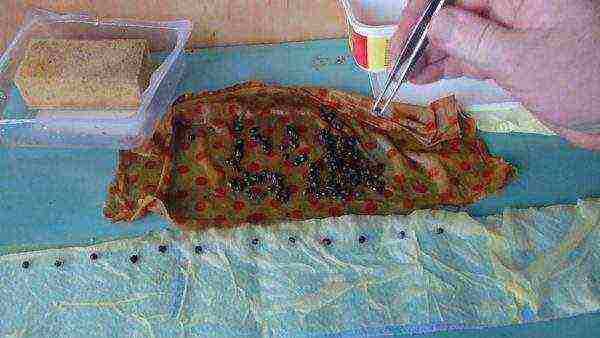 Preparing seeds for germination in toilet paper
Preparing seeds for germination in toilet paper
Stratification
Selected seeds are placed in a damp cloth and plastic bag and stored in the refrigerator for 6-8 weeks. The optimum temperature is + 3⁰C - 0⁰C. It is required to inspect the seeds regularly, once every 10 days.
To exclude the appearance of mold, it is necessary to periodically rinse the bones with water. Then, after 1.5-2 months, the shell will begin to crack. This marks the end of stratification.
At the final stage, the seeds are placed on a damp cloth, without covering, in a warm place. After about three days, thin roots will begin to appear. It is time for sowing in the ground.
Some gardeners do not always apply the stratification process. For this, crops are sown before winter, in open ground, while the percentage of germination is lower.
You should not use seeds from unripe berries for planting. They have low germination, or weak shoots with low productivity grow.
Sowing at home in a pot
Sowing stages
- Prepare the soil. For these purposes, use a store or mix independently in equal proportions sand, humus and garden soil
- It is advisable to use a separate container for each seedling.Previously, a drainage hole is made in each and several pebbles are poured onto the bottom. Fill with an earthy mixture.
- The seed needs to be planted to a depth of 1-1.5 cm into a pot and shed.
- Well-lit windows, preferably facing south, are ideal places for further growth. It remains only to germinate the planting.
- To preserve soil moisture before germination, the cups are covered with foil.
For the successful growth of seeds, it is necessary to withstand the temperature regime. The optimal daytime temperature should not be lower than + 20⁰C, and the nighttime temperature should not be lower than + 15⁰C. Then, after 7-11 days, a sprout will appear.
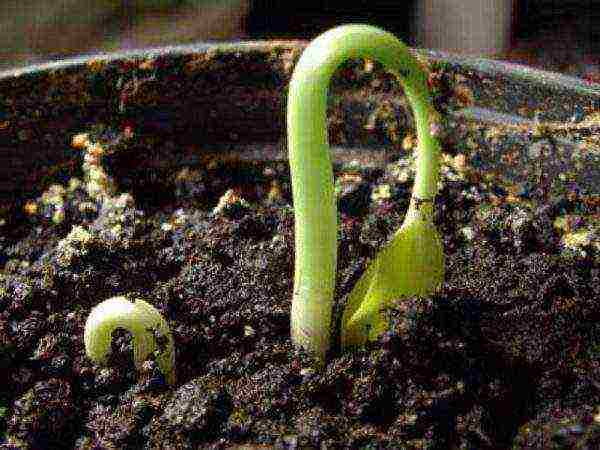 The grape that gave the first sprout
The grape that gave the first sprout
Plant care
An important factor for the growth of a strong plant is periodic, moderate watering and the presence of sunlight for at least 8 hours a day. In addition, the main care is loosening and feeding. Nitrogen or phosphorus fertilizer is applied every 10 days.
At the initial stage, it is better to water young shoots from a spray bottle so as not to disturb the root system... The seedling is inspected daily for the absence of spider mites. The pest is able to destroy the plant.
If in the plans the grapes will be used to decorate the room, then at a height of 10 cm the seedling is transplanted into a container with a volume of 3-4 liters.
Planting in open ground is performed in the first days of June.
Before transplanting, the seedlings are hardened for 5-7 days. To do this, during the day they are put out on the street, in a place quiet from drafts, in partial shade. These activities contribute to the rapid establishment and elimination of negative consequences from sunburn.
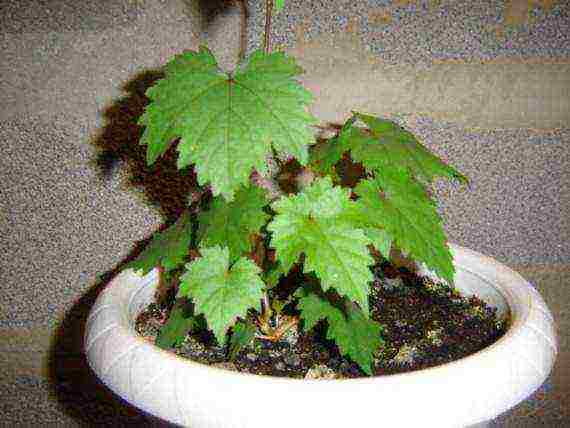 Slightly grown grapes that can be transplanted into open ground
Slightly grown grapes that can be transplanted into open ground
Outdoor transplant and vine care
When the seedlings reach a height of 20-30 cm, they are transplanted into the garden.
- The place for landing is chosen sunny, calm, preferably hidden from the north winds.
- The soils should be light, breathable and well-drained. In humid lowlands, grapes freeze.
- A mixture of humus, sand and soil is poured into the dug holes at a distance of 1.5-2 meters from each other.
- Grape seedlings are planted in moist soil on a warm, sunny day.
- Each shoot is fixed to a vertical support (more often these are trellises 2 meters high with a stretched wire).
During the first summer, care consists of regular watering, loosening and weeding. Under favorable conditions, the grapes will root well and reach a height of 1-2 meters in the first year.
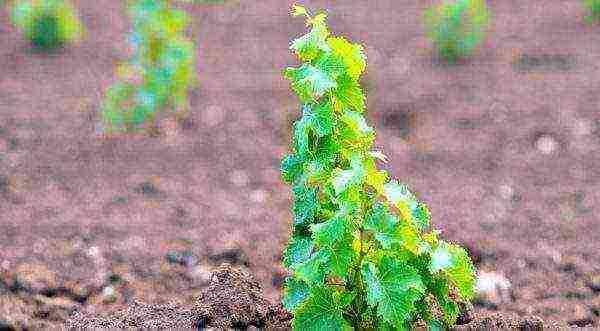 Transplanted young vine in open ground
Transplanted young vine in open ground
Formative pruning of the vine is recommended for the third year of growth. With the right choice of plant variety, the harvest is expected in 3-4 years, in rare cases after 2.
Growing grapes from seed at home is a more time consuming process. This is due to the long growth period before the first harvests. And it does not always bring the expected effect. Therefore, in case of failure, and varietal qualities will not be preserved, the seedling is used as a stock.
Everyone knows such a plant as grapes, the cultivation of seeds of which at home is of interest to many gardeners. To get a fruiting bush, you need to know the correct technology for this method and tune in to the fact that it will last for quite a long time. Not many growers and gardeners use this method, since it is quite complicated and not everyone is able to cope with it.
Why are grapes grown at home?
Ways to grow grapes at home:
- using cuttings;
- using seeds.
The last method is the most time consuming and painstaking, so not many people take it. Let's consider just such a growing method in more detail.
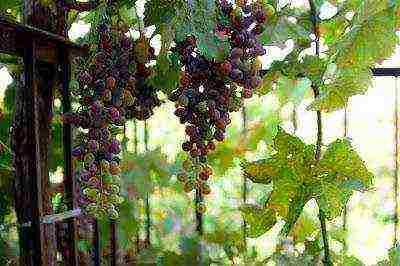
When asked whether it is possible to grow grapes from seed at home, experienced breeders and winegrowers answer positively. But the harvest is quite modest, so gardeners are doing this for the sake of:
- Excitement.Growing such a plant is long and difficult, and this process requires a lot of effort, constant attention and care. Not every gardener will be able to grow a garden crop in a pot from a small seed.
- Experiment. For those who develop new varieties, grapes from the seed can become a kind of "guinea pig" on which you can try out various feedings, as well as track how the plant reacts to pests, diseases and other negative factors.
- Rootstock. Grapes, grown from seeds of which takes place in an apartment, are used as a support for an ordinary garden vine. This will also save on seedlings.
- Decorating. Grown "home" grapes are no different in appearance from garden grapes. And since the plant itself is very beautiful, you can decorate your balcony with it.
What kind of harvest should you expect?

Berries obtained from the "home" vine, their taste is significantly different from the garden. Grapes begin to bear fruit after planting in 4-5 years. For the first time, the yield is expected to be rather low, and the taste of the berries is sour or have a weak taste.
Seed preparation
Due attention should be paid to the preparation of seeds for planting. It is best to choose new varieties, as this ensures that the grapes grown from the seeds at home will be resistant to various diseases and adverse conditions. The seeds must be extracted from the most ripe berries, differing in varietal qualities, without deformation and without signs of rot.
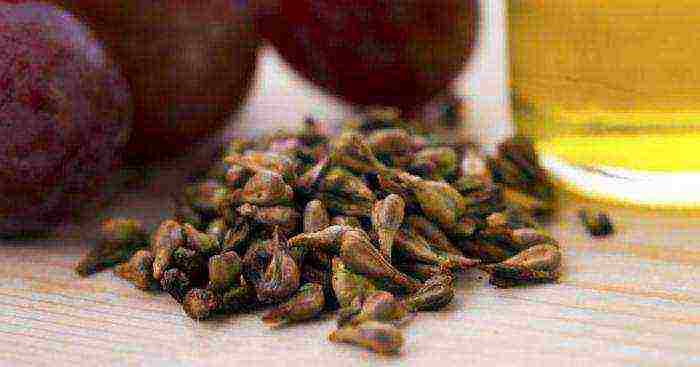
Grape seeds that will be used for home cultivation must be very large and preferably beige-brown in color. They are carefully and very thoroughly washed under water, and then not dried, but immediately laid out in moistened nylon bags and wrapped in ordinary plastic wrap. It is recommended to place prepared grape seeds on the lowest shelf in the refrigerator. They should be inspected regularly and flushed periodically. As soon as cracks appear on them after a few months, this indicates their readiness for planting in the ground.
Planting technology
Is it possible to grow grapes from seed at home? If done correctly, then it is quite feasible. Sprouted grape seeds are planted in individual containers, which are filled with fertile soil. The optimum soil consists of a mixture of humus and sifted sand. Before sowing seeds, the soil should be disinfected; for this, the soil is calcined in an oven at a high temperature or spilled with boiling water with the addition of potassium permanganate.
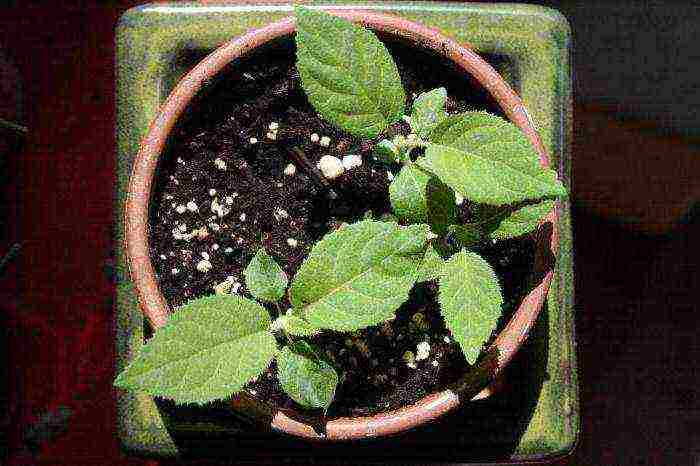
After the containers are filled with soil, it is moistened and the prepared grape seeds are planted to a depth of 1-1.5 cm. In order for the sprouts to appear as early as possible, it is better to place the seed pots on the windowsill, where there is good illumination and a lot of heat.
Growing features
If, when growing grapes from seeds at home, an optimal temperature regime is created, and the crops are provided with the necessary amount of light, then sprouts can be expected to appear in 10 days.
The conditions for growing grapes are as follows:
- plants must be regularly watered with water at room temperature, but waterlogging or severe drying of the soil must not be allowed;
- the soil must be loosened, and this must be done very carefully so as not to harm the sprouts;
- if such a need arises, then irrigation is supplemented with fertilizing with mineral and organic fertilizers;
- the plant should be protected from drafts, and if the weather is very sunny, then the grapes should be shaded.
It is necessary to regularly inspect seedlings, since young plants are often affected by diseases or spider mites. In the spring they are transplanted into larger containers.

If grape seedlings are grown, then next year they are recommended to be transplanted into open ground. It is also very important to harden the plants before they are planted in a permanent place. Thanks to this procedure, they quickly adapt to new growing conditions and take root faster.
Tips & Tricks

Growing grapes at home lasts until it reaches a height of 1.5-2 meters. After that, seedlings can only develop in the open field. In this case, the conditions for growing the plant are as follows:
- The landing site should be well lit and not in a draft. It is best if there is protection from the north side.
- It is advisable to choose a site with light, breathable and moderately moist soil.
- Usually grapes are grown on trellises, which are very strong supports of two meters in height with a stretched wire. There should be a distance of 1.5 or 2 meters between the planted plants.
- Grapes need to provide good drainage in the form of medium-sized stones or broken bricks. It is recommended to fill it up with high-quality and fertile soil.
In the future, caring for the planted grapes provides for regular watering, loosening the soil, and fertilizing. If you properly care for the plant, then it will begin to bear fruit in three or four years after planting the grape seed.
Conclusion
Thus, we have sorted out what grapes are, growing from seeds of which takes place in an apartment or a private house. This process is very complicated and only experienced gardeners can do it. You can not only decorate your own balcony with a grown vine, but also enjoy berries.
.
Beginners in the cultivation of grapes can delight themselves with the harvest of delicious berries, growing it on the estate. Few people know that a healthy fruit can be grown independently at home on the balcony and even on the windowsill. It remains to choose a growing method, using cuttings or seeds.

Growing grapes attracts both experienced farmers and amateur gardeners.
In the form of a houseplant, grapes, sprouting on the balcony, purify the air. The leaves of bushes of different varieties, beautiful and varied in shape. In addition to the decorative function, the plant can bear fruit by three or four years of life at home.
Let's consider two main ways of breeding grapes at home. These include - reproduction using seeds, the second - the vegetative method (cuttings).
Breeding grapes from seeds for beginners
Growing grape seedlings from seed is a very painstaking and lengthy process. The plant will begin to bear fruit in the fourth, fifth year. There is little desire for a novice winegrower; for this method, you will have to look for seeds for growing. You can pick up suitable varieties, there are enough of them, but it is important to take seeds from a strong vine. The advantage of the plant is its resistance to diseases, facilitating the process of soil preparation, cultivation.
Different grape varieties grow in specific climatic conditions. Seeds are sown in the spring, if they are sown freshly harvested in the fall. Novice gardeners should choose self-pollinated varieties. The disadvantage of growing grapes from seeds is that the parental properties are not repeated and the berries change the taste. Beginners in this business should think, they need grapes grown in a similar way.
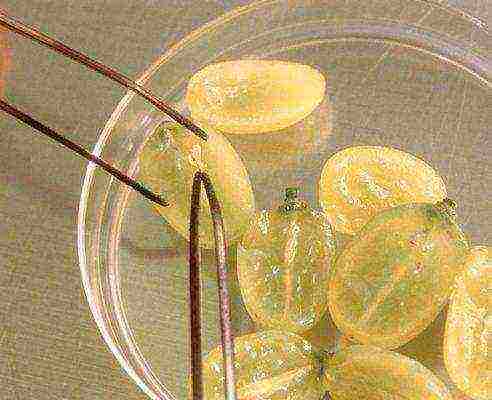
Seeds collected from fresh grapes are planted immediately, in the fall.
Selection and preparation of seeds for planting
First you need to choose a ripe bunch. At home, a seed can germinate, which has a dark shell with a light core, is solid and sinks in water. It is taken out of the berry, washed well, soaked in water for a day, then stored in the refrigerator for two to three months (to improve germination).The process of high-quality germination of seeds should take place in cold, damp conditions (in nature - in winter in the ground). The storage temperature for seeds is from 0 to +3 degrees.
To prevent mold from curling, they are taken out every 10 days, examined and washed with water. The result of stratification appears after 2-3 months, when the grape seed begins to crack, this is a signal that it is ready to plant it in the soil. The germinated seed is moved for two days in a warm place (battery) on a moistened cotton napkin.
Soil preparation and planting seeds
As soon as white roots begin to emerge near the bone, it is planted in a previously prepared mixture. Fertile soil for planting has a composition in a ratio of one to two sand and humus. For good strengthening of the seed and turning it into a vine, each seed must grow in a separate pot, at a depth of no more than 1.5 cm.
It is allowed to plant seeds in one, volumetric container, at a distance between the shoots of 5 centimeters from each other.
Planting pots with seeds are placed in a warm, well-lit place. Ideal - on a windowsill in the southern part of the house. To prevent drying out, soil moisture is controlled by covering the pots from above. After 8-12 days, the seeds give small sprouts.
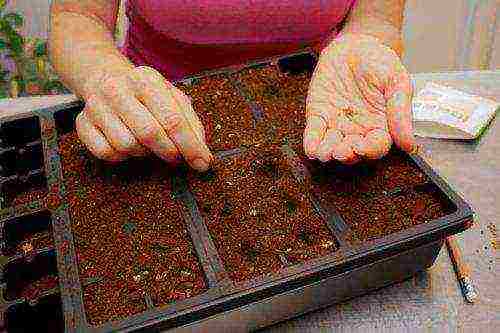
Grape seeds are planted at a distance of 5 cm from each other
The crucial stage of good care of grape sprouts begins. It is necessary to carry out mineral and organic feeding, regulate humidity, light fluxes - at least 8 hours a day. Gardeners recommend feeding the sprout once every 10 days, alternating nitrogen fertilization with phosphorus. The systematic loosening of the soil has a positive effect on the growth of seedlings.
At the beginning of summer, the seedlings grow by 8-10 centimeters, then I decide the question of transplanting. If the owner plans to continue growing them in the room, you need to transfer the seedling into a container with a volume of 3-4 liters and put it on the balcony. The second option is to transplant sprouts directly into the ground.
Chubuki, sprouting on the balcony, are transplanted into open ground in late autumn. In the first year, the vine is not pruned until after the plant has faded for the first time. The vine grown on the balcony reaches 2-3 meters in length. Further, standard preparation for the winter is carried out. They cover the seedlings, for this they remove the vine from the support, fold it into a ring and bend it down to sprinkle it with earth. The raised top of the seedlings is wrapped with prepared material (black film, agricultural cloth). For 3-4 years of careful cultivation of grapes, the fruiting period begins.
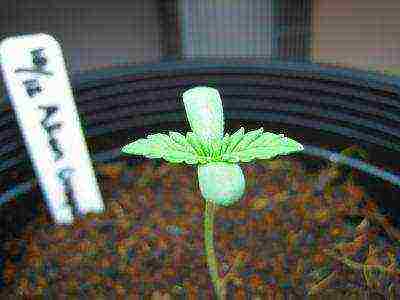
Until the sprout has reached a length of 10 cm, it cannot be transplanted.
Growing seedlings at home
The vegetative method provides for the cultivation of grapes in spring, summer, winter cuttings. For high-quality cultivation of grapes, it is necessary to correctly prepare the cuttings (shanks). Chubuki are ready-made cuttings that have one or five buds. Growing grape seedlings using the vegetative method does not violate the palatability of the fruit. This method of growing vines is reliable for the formation of good quality seedlings. From the step-by-step execution of the instructions, the result of the venture depends on getting delicious grapes.
The preparatory phase of the breeding of shanks includes:
- Cutting the shanks.
- Storage of workpieces.
- Preparation for growing vines.
A favorable autumn period for grape cuttings. With the onset of cold weather, when the leaves of the plant fall off, gardeners start cutting the vines. For high-quality reproduction of shanks, take medium shoots from the upper part of straight vines from fruit branches of grapes. After grafting is completed, they are soaked in a bucket for a day and sent for storage.
Then each stalk is taken out of the water, marked, sorted into a bunch and wrapped with a damp cloth, sent to storage in a refrigerator or cellar. At 100% humidity, the storage temperature is - + 4 ° C.Periodically, the safety of the shanks is checked so that mold and early discoloration of the kidneys do not appear.
From the second month of spring, the process of cuttings is continued, for this the seedlings are thawed and checked for viability. A transverse cut is made with a pruner, when water drops appear, defrost further. Lack of water indicates dried seedlings, and digging in indicates that it is rotten. The workpieces are taken from the refrigerator, washed in cool water, disinfected in manganese for 6 hours. Then the sections are updated, and the cuttings are left in clean water for two days.
The color of the slice matters - light green without black dots. For active growth of the root system, a root formation stimulator is added to the water.
The stage of growing cuttings at home continues.
The stems are planted in disposable cups or bottles in order to better observe the development of sprouts. Some gardeners practice planting shanks in boxes, other containers or directly into the ground, so as not to disturb the roots of the plant once again.
Winter cuttings, after treatment with a stimulant, planting in greenhouse conditions, take root up to 90 percent. During the growing season, the shoots reach 1.5 meters, by the end of the first year, the roots germinate up to 30-40 cm long. Only from the fall of the second or spring of the third year, seedlings are planted in open ground in a permanent place.
Cuttings are planted in glasses and placed in boxes
Growing grapes in barrels
Winegrowers have developed a new method of growing vines in barrels. This option is suitable for areas where the summer day is short. It is as follows:
- pick up plastic barrels with a minimum volume of sixty-five liters (that is, for 50 liters of soil). Before planting grapes in barrels, drilled at the bottom up to 40 technical holes, 10 millimeters wide;
- for drainage, expanded clay is settled into the lower part of the barrels, you can use slag, as well as broken brick. The space is filled with soil mixture, the composition of which is close to the components of the garden soil: sand, add humus, peat;
- when the middle of autumn comes, the sprouts in barrels are settled on the soil of the estate so that a small angle is obtained with a distance of 1 meter between them. During cold weather, to prevent shoots from freezing in barrels, they are sprinkled with soil and covered with slate;
- starting in April, the barrels are removed from the ground and placed in the greenhouse. Thus, the vine, planted in the soil of the container, undergoes heating and blooms by the month of May;
- grapes are brought out into the street in early summer, placed on the south side, with the provision of shade for the plant. A year of laborious efforts and in July the plant will give a long-awaited harvest.
Varieties of small stature are planted in barrels - "White Delight", experts suggest "Dimon", "Madeleine Selenium", others are known. Planting grapes in this way is aged from eight to ten years, then the containers are cut, the bushes are taken out for transplanting into open ground.
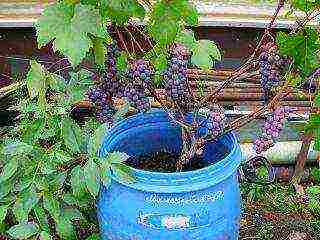
For planting grapes, barrels with a size of at least 65 liters are selected
Features of growing grapes on the balcony
Breeding and growing grapes on the balcony is best done on the south side of the house. With good watering, the plant gives a fairly good harvest of fruits. Also, the vine shades the window and is a decorative element of the balcony. Not all grape varieties are suitable for living on a windowsill or balcony. Popular varieties include Delight, Timur, medium-sized varieties such as Prim, Russian early will still take root. In order for the plant to develop, the following conditions must be met:
- the main condition for growing a vine is sufficient lighting, only under direct rays the plant will bear fruit;
- the use of growth stimulants during the cultivation of grapes on the balcony improves the ovaries and accelerates the ripening of berries;
- pay special attention to the composition of the soil, since the plant is not in its natural environment. The soil consists, on average, of five parts of useful substrates;
- grape varieties growing in a room or balcony must be bisexual;
- as they grow, the grapes will need to be transplanted into larger forms. In the first year of breeding, the plant will live in a 4-5 liter pot, after 2-3 years it will need to be transplanted into a conical container of 8-10 liters;
- in winter, grapes can spend on the balcony in a pot, if they are wrapped in blankets and covered with foil. If there is a basement, the plant, after pruning the vine, can be lowered into it until February.
With proper care of the vine bush on the balcony, you can expect a healthy looking green vine and many years of fruiting.
Growing grapes from seeds on your balcony or windowsill is a rather difficult path and does not always justify itself. The plant can bear fruit only by three, four years of life.
For novice gardeners, growing grapes from cuttings is suitable. This method is much easier and with proper care of the plant, from year to year, it will delight you with a tasty and healthy harvest.
Subscribe Be aware of new products on our site

Growing grapes is not as difficult as it is commonly believed. Large bunches with juicy fruits will brighten up your vineyard if you follow the basic rules carefully, taking into account the advice of experienced growers.
What should you consider before growing grapes?

Vineyard photo
Why does not every gardener manage to grow good grapes on their plot so that they do not freeze over the winter, do not rot in the summer and bring a bountiful harvest of decent quality? The fact is that the cultivation of this culture must be taken seriously.
First of all, you should choose a suitable grape variety that will feel comfortable in your area. For instance, growing grapes in the middle lane gives good results only when using winter-hardy varieties with early ripening. Among the new varieties, you will find many excellent options that are resistant to fungal diseases, pests and severe frosts, with high yields and the ability to ripen even in a cloudy short summer.
Video about growing grapes
Black varieties tend to require more sunlight and warmth than light grapes, although there are some hardy black varieties.
Pay special attention to the appearance of the seedling when buying. Look for any mechanical damage, signs of drying or strange stains on the plant? Healthy grape seedlings should have at least three well-developed roots and a shoot about half a meter high. In order not to doubt the quality of planting material, buy seedlings in the nursery, and preferably in a container - this way the plant will take root better.
It will be easier for a novice gardener to plant a ready-made grape seedling, especially if you want to create a vineyard from scratch. Experienced growers can easily cope with cuttings, but those who are not afraid to experiment can try growing grapes from seed.
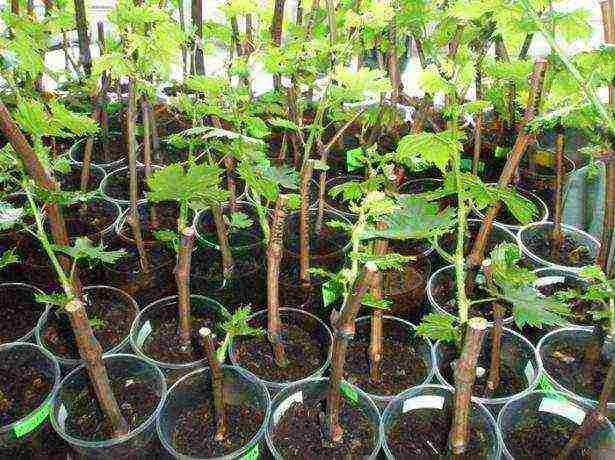
In the photo grape seedlings
Step-by-step technology for growing grapes
When starting to create a vineyard, it is important to take into account the climatic features: if the region is characterized by little snowy winters and severe frosts, it would be preferable to plant grapes in trenches or holes, but if there is enough snow in winter, but the summer is too short and cold, it is better to plant seedlings in bulk ridges. In the pits, the root system will be reliably protected from freezing, and in the ridges, the roots will receive more heat during the summer months.
You can plant grapes both in spring and in autumn, depending on which planting material you have chosen. Consider the most common and simplest option - the autumn planting of grapes with seedlings in planting holes.
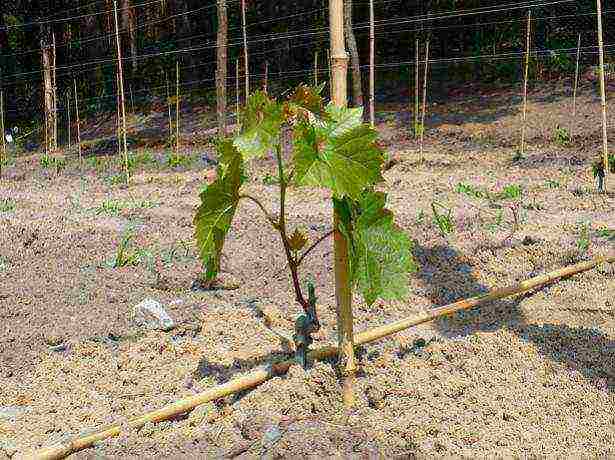
In the photo, planting grapes
Stages of planting a grape seedling:
- choose for planting well-lit by the sun, a flat place where there are no drafts and excessive moisture;
- dig a planting hole according to the size of the root system, with a depth of 0.2 to 0.5 m (less for clay soil, deeper for sandy soil);
- mix the soil from the pit with organic and complex mineral fertilizers;
- put a layer of gravel on the bottom of the hole, and put branches or planks on top;
- install a pipe with a diameter of 10 cm or more in order to water the grapes and fertilize the soil through it;
- form a small mound of the prepared earth on top of the layer of gravel and branches;
- before planting, dip the roots of a grape seedling in a solution of clay and rotted mullein (clay is twice as much as a mullein);
- cut the shoots into a couple of buds and dip them in melted paraffin;
- place the seedling in the hole, spreading its roots;
- fill the hole with the remaining soil and tamp it carefully;
- pour warm water over the grapes;
- cover the hole with compost or rotted manure.
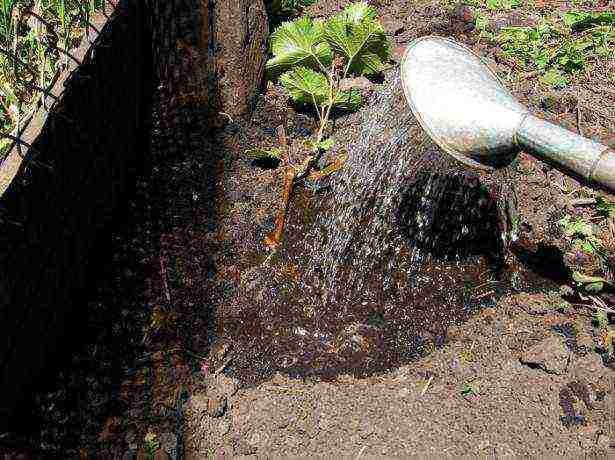
Photo of watering grapes
If you are going to plant several bushes of grapes, leave at least one and a half meters between them. At the same time, it is recommended to arrange plants from the south to the north.
How to properly grow and care for grapes?
For the correct formation of the vines, it is necessary to install a strong trellis. The simplest construction consists of two metal or wooden posts with several rows of wire between them. As the vines grow, they are neatly tied to a wire, giving them the desired direction.

In the photo grapes
In the first three years, pay particular attention to planting: carefully loosen the ground two days after rain or watering, do not allow leaves to wither and dry out the soil from lack of moisture, destroy weeds. From the fourth year on, it is sufficient to water the vineyard three to four times per season during the most important phases of development.
Periodically, the vines should be fed through drainage pipes and along the leaves, and treated with suitable fungicides against pests and diseases. Inspect the plants more often in order to start the fight against dangerous enemies of grapes in time and prevent the death of the entire vineyard!
Video about the technology of growing grapes
Prune the grapes every fall after the fall. With the onset of the first night frost, remove the vines from the supports, pin them to the ground with brackets, treat with a solution of copper sulfate and cover with plastic wrap. In the spring, do not rush to open the grapes until frosts and sudden changes in temperature stop.
By following the grape growing technology outlined in this article, you can create your own vineyard and enjoy delicious, juicy fruits every year.
Rate the article:
(12 votes, average: 3.9 out of 5)
The extreme climate of a sunny berry is not a hindrance. And getting a good harvest of grapes in the second or third year after planting is an achievable goal even for beginners. So how to stop dreaming and start growing grapes ...
First, let's decide on the two most important tasks when growing grapes - we will choose a place for planting grapes and the varieties that we will plant. In principle, the vine will grow almost everywhere (except for a solid shade), and if you take care of it, at the very least it will bear fruit. However, competent planting in the right place will allow you to get really good yields with much less effort. Remember that planting seedlings of low-quality varieties in a vineyard will take your time, energy and good mood. You may be undeservedly disappointed in the grapes, although the mistake will be entirely yours.
Place for planting grapes
The vineyard should be sunny and sheltered from the wind, for example by the south wall of a house, a barn or a south-facing fence with well-drained soil. If there is a minimum slope on the site, plant the grapes on a gentle southern or south-western slope, orienting the row in the south-north direction. If the plot is flat and the southern walls are occupied, create a place for your grapes by building in any convenient place on the plot a nice solid fence 1.8–2 m high, oriented along the "east-west" line. And you will immediately understand the secret of the monastery vineyards! You can also use for this purpose dense hedges or screens from available materials, for example, from vines or reeds.
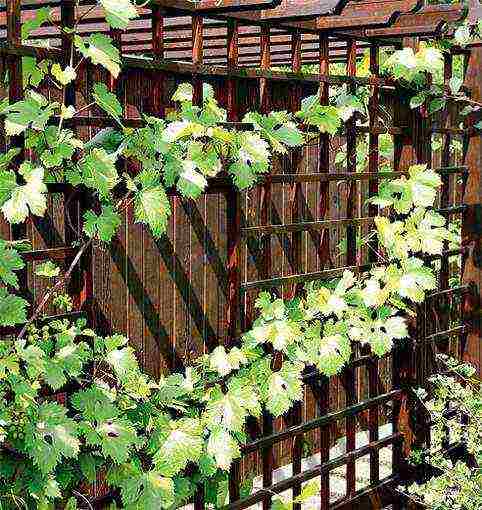
Tips for a new wine grower
-
The method of planting grapes depends on the type of soil. Variants are possible, but usually it is recommended to plant grapes on sandy soils in trenches, and on poorly heated loams and clays and in areas with close groundwater occurrence, it is recommended to plant on ridges, which in the old days were called "created".
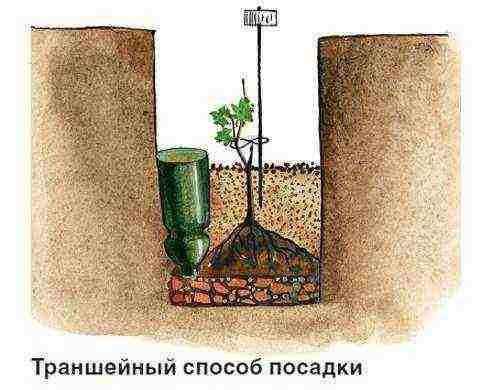
For watering and fertilizing the grapes, I place plastic bottles with a cut-off bottom between the seedlings. For table varieties, as the bushes grow older, I replace them with asbestos-cement pipe trimmings, and for “techies” (wine varieties) I remove them altogether after three years. Mature wine grapes have to get their own water from the soil, and the deeper the roots, the better the wine from its berries.
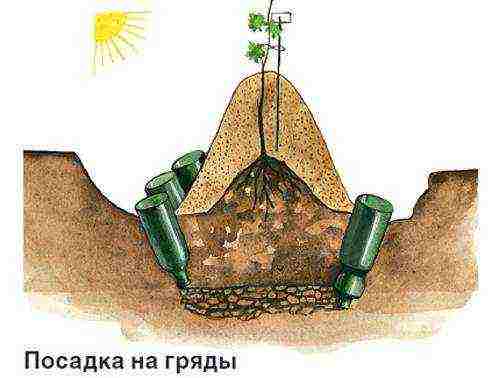
-
Do not rush to plant seedlings "for permanent residence", especially if these varieties are on trial. Let them live until the first signal brushes in the school (where it is easier to cover). In the first year, some northerner growers do not plant seedlings in open ground at all, but keep them there in mobile containers (for example, in buckets), half buried in the ground. In the fall, containers with seedlings are moved to the basement, and in late spring they are planted. Such seedlings begin bearing fruit earlier.
-
Don't spontaneously plant vines. If your grape bushes are not in a "spot" planting, planning of the vine plot is necessary. Group varieties by purpose, as they have different planting intervals. The distance between bushes of varieties for juice and wine purposes is 0.8 m, for table varieties - at least 1.5 m, between rows - 2–2.5 m. It is advisable to clarify the strength of growth of the selected varieties in order to correctly calculate the desired place. Grouping varieties by ripening and frost resistance will facilitate the care of the grapes. You will not need to spray and cover everything to the maximum.
-
Do not plant grafted seedlings (from European and southern nurseries) vertically, but place them practically lying at the maximum possible angle, otherwise there will be problems with the ripening of the vine. Gradually translate them into your own roots.
- Remember that grapes have the property of vertical polarity. When opening, tie a fruitful arrow on a trellis or stakes only horizontally - then all annual green shoots will grow equally. With a vertical garter, shoots grow intensively only from the upper eyes, and from the lower ones, they grow weakly or do not grow.
-
Limit watering. It is only obligatory to water young vines for the first 2 years and water-charging watering, which is common for all varieties, in the fall. Stop watering 7-10 days before the expected flowering, as excessive moisture causes the color to shed and delays the ripening of the crop.
-
Do not use sprinkling, otherwise you will provoke disease. Arrange drainage channels and place irrigation pipes on the side of the row spacing no closer than 30-50 cm to the base of the bush. Grapes do not like wet leaves and damp ground. If possible, arrange a visor over the grape bushes.
-
Conduct green operations sparingly and on time. Simultaneous removal of all growth points on the shoot is unacceptable: both chasing the top and pinching the stepsons. After all, there is a danger that the wintering buds of the bush will start to grow and its potential will dramatically weaken. Do not break the stepchildren completely, leave 1-2 sheets.Carry out minting in August, immediately after straightening the crown.
-
Pruning the grapes is necessary, otherwise the berries are crushed, and the bush will grow unnecessarily. But in the year of planting, there is no pruning, except for the removal of unripe green parts of the shoots in the fall. From the 3rd year, cut the shoots according to the recommendations (short or long pruning), but do not mindlessly follow the recommended total load, since your conditions - relief, soil, the sum of active temperatures (CAT) - will correct it. Write down from which bud the fruiting shoots grow specifically for you.
Read more: Pruning grapes for beginners .
-
Do not carry out autumn pruning before natural leaves fall or night temperatures are below freezing (early November). Do not prune in the spring, as the "crying" of the vine (sap outflow) weakens the plant.
Read more: How to stop the crying vine>.
-
In the north, it is more reliable to use non-standard formations of a fan or semi-fan type, and not high-standard ones, including for arbors.
Read more: Cordon formation and pruning of grapes.
Read more: Forming grapes for growing on a gazebo>.
-
Winter shelter for the first 2-3 years is needed for all seedlings. The first year the grapes grow tied to a temporary trellis. In autumn, shoots are removed and covered with a two-three-layer air-dry shelter. As a bedding - spruce branches or a board, on top of the seedlings - a layer of spunbond or corrugated cardboard and a film on top (roofing paper, old linoleum). Snow will complete the rest. Leave ventilation slots at the ends of the shelter.
-
Do not remove the cover immediately and completely in the spring. And when removed, leave a couple of layers of spunbond or lutrasil nearby in case of frost.
- Record the timing and characteristics of planting, flowering, ripening, pruning and loading of grapes in a diary. Otherwise, the most valuable information for the analysis of variety testing will be forgotten and lost. And you and the next generation of northern winegrowers, who will definitely come after you, need it so much.
How to grow grapes in the middle lane.
Winter hardy grape varieties
The most necessary requirements for grape varieties in the Moscow region and to the north are frost resistance, the ripening period of the crop and vines. But you shouldn't put so-called “non-concealment” at the forefront. This concept is relative and does not depend on the variety, but on what are the minimum temperatures in winter in your country house. In the first step, choose the earliest frost-resistant varieties. Later, with experience, an understanding will come that northern viticulture also provides us with certain bonuses, for example, in the form of long daylight hours, which partially compensates for the missing warmth of the grapes. And then you can try growing later varieties.
In addition, in the north, there are practically no diseases and pests of grapes. However, it is always better to prevent danger. There are so-called complex-resistant grape varieties - with high resistance to both frost and disease.
Read more about grape diseases and how to treat them.
Also determine the purpose of the grapes. Why do you need it: for the table, for juice and wine, for decorating the gazebo, or just "so that there was"? Today there are more than 15,000 grape varieties, so there is plenty to choose from.
For beginners, I would advise tasty and unpretentious table varieties ‘Agat Donskoy’, ‘Aleshenkin’, ‘Yubileiny Novgorod’, universal ‘Platovsky’, ‘Crystal’, ultra-early table ‘Krasa Nikopol’, as well as some universal Amur hybrids A.I. Potapenko and F.I. Shatilova. Those who have children should pay attention to the super-early and tender-sweet varieties ‘Liepaja Yantar’ and ‘Early Tsiravsky’ (selected by G.E. Vesminsha), as well as the ‘Krasa Severa’ variety with a high content of useful folic acid. From the listed grape varieties, choose no more than four to five for the first planting.
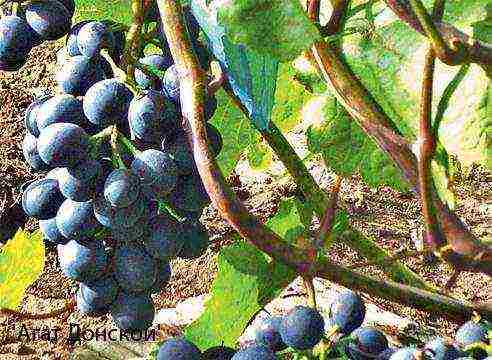
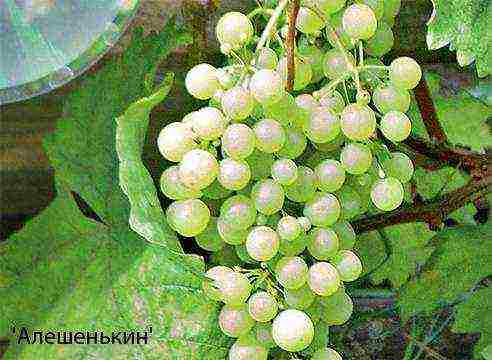

How to buy grape seedlings and rooting cuttings
The most reliable sources of planting material are wine growers' clubs and forums, where enthusiastic and experienced gardeners and collectors communicate, as well as MOIP and TSKHA. You should not buy seedlings and cuttings at spontaneous roadside markets and exhibitions (of course, this does not apply to the stands of well-known nurseries).
How to buy grapes and choose a good seedling.
You can ask a question to the author of the article, wine grower Olena Nepomniachtchi, here .
You can find out how to grow other plants, what gardening work you need to plan, from other articles on our website. Also, please pay attention to the information block to the left of the text. The links located in it lead to articles of related topics.


